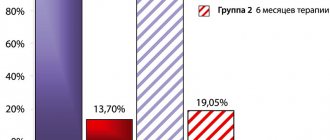Pharmacodynamics and pharmacokinetics
Pharmacodynamics
A monophasic combination drug that suppresses the secretion of gonadotropic hormones, inhibits the maturation of follicles and suppresses ovulation. The hormonal substances included in the composition increase the viscosity of the mucus of the vagina and cervical canal and change the endometrium, which prevents the penetration of sperm into the cervical canal, on the one hand, and reduces the likelihood of egg implantation, on the other. Affect the movement of sperm in the fallopian tubes.
Pharmacokinetics
Gestodene is quickly absorbed after administration and after 1 hour its maximum content is noted in the blood. In the blood, it binds to albumin and special globulin (SHBG) by 69%. When taken daily, the content of gestodene in the blood increases 4 times. While taking the second half of the tablets, a state of equilibrium of its level in the blood is noted, the decrease of which occurs in two phases. Gestodene is completely metabolized and is excreted in the form of metabolites in urine and bile (half-life 24 hours).
Ethinyl estradiol is also completely absorbed from the intestine. Its content in serum peaks after 1-2 hours. The decrease in the level of the substance in the blood occurs in two phases. Ethinyl estradiol in the form of metabolites is excreted in bile and urine. Equilibrium concentration is achieved after 5-6 days from the start of taking the drug.
Contraindications
- angina pectoris, hypertension, myocardial infarction;
- history of cerebrovascular accidents, including transient ones;
- presence of risk factors for thrombosis ;
- diabetes mellitus complicated by vascular damage;
- pancreatitis;
- severe liver and kidney diseases;
- decreased blood clotting;
- hormone-dependent breast tumors ;
- suspected pregnancy ;
- bleeding from the genital tract of unknown etiology;
- epilepsy;
- retinal vascular thrombosis;
- thrombosis of the veins of the extremities;
- overweight;
- hypersensitivity to gestodene or ethinyl estradiol.
Subtleties of application
Estrogen in COCs helps eliminate LDL and increase HDL and triglyceride levels. Progestins counteract estrogen-induced changes in lipid levels in the body.
- For acne, medications containing cyproterone acetate, drospirenone or desogestrel are prescribed as a progestin. COCs containing cyproterone acetate and ethinyl estradiol are more effective for acne than the combination of ethinyl estradiol and levonorgestrel [4].
- For hirsutism, medications containing progestogens with antiadrogenic properties are recommended: cyproterone acetate or drospirenone [5].
- Combinations of estradiol valerate and dienogest are more effective in reducing menstrual blood loss than ethinyl estradiol and levonorgestrel [6]. In addition, the intrauterine system is indicated for the treatment of menorrhagia.
- Preparations containing drospirenone 3 mg and ethinyl estradiol 20 mcg are recognized as the most effective combination for correcting PMS symptoms, including those of a psychogenic nature [7].
- Taking oral contraceptives increases systolic blood pressure (BP) by 8 mmHg. Art., and diastolic - by 6 mm Hg. Art. [8]. There is evidence of an increased risk of cardiovascular events in women taking COCs [9]. Due to the increased likelihood of developing myocardial infarction and stroke in patients with arterial hypertension, when prescribing COCs, the benefit/risk ratio must be carefully weighed.
- In non-smoking women under 35 years of age with compensated hypertension, COCs can be prescribed with careful monitoring of blood pressure during the first months of use.
- In cases of increased blood pressure while taking COCs or in women with severe hypertension, an intrauterine system or DMPA is indicated [10].
- The selection of a contraceptive for patients with dyslipidemia must be carried out taking into account the effect of the drugs on lipid levels (see Table 5).
- Because the absolute risk of cardiovascular events in women with controlled dyslipidemia is low, COCs containing 35 mcg or less of estrogen can be used in most cases. For patients with LDL levels above 4.14 mmol/l, alternative means of contraception are indicated [8].
- The use of COCs in women with diabetes mellitus accompanied by vascular complications is not recommended [2]. A suitable option for hormonal contraception for diabetes mellitus is the intrauterine levonorgestrel-releasing system, and, as a rule, no dose adjustment of hypoglycemic drugs is required.
- The results of epidemiological studies examining the risk of myocardial infarction when oral contraceptives are prescribed to women who smoke are contradictory. Due to limited convincing data, COCs are recommended to be prescribed with caution to all women over 35 years of age who smoke.
- Obesity with a body mass index of 30 kg/m2 and above reduces the effectiveness of COCs and transdermal GCs [8]. In addition, the use of COCs in obesity is a risk factor for venous thromboembolism. Therefore, the method of choice for such patients is mini-pills (gestagen-containing tablet contraceptives) and intrauterine contraceptives (levonorgesterel-releasing system).
- Use of COCs with estrogen dosages of less than 50 mcg in nonsmoking, healthy women over 35 years of age may have beneficial effects on bone density and vasomotor symptoms during perimenopause [8]. This benefit must be considered in light of the risk of venous thromboembolism and cardiovascular factors. Therefore, women of the late reproductive period are prescribed COCs individually.
List of sources
- Van Vliet HAAM et al. Biphasic versus triphasic oral contraceptives for contraception //The Cochrane Library. — 2006.
- Omnia M Samra-Latif. Contraception. Available from https://emedicine.medscape.com
- Collaborative Group on Hormonal Factors in Breast Cancer. Breast cancer and hormonal contraceptives: collaborative reanalysis of individual data on 53,297 women with breast cancer and 100,239 women without breast cancer from 54 epidemiological studies. Lancet 1996; 347(9017):1713–1727.
- Carlborg L. Cyproterone acetate versus levonorgestrel combined with ethinyl estradiol in the treatment of acne. Results of a multicenter study. Acta Obstetricia et Gynecologica Scandinavica 1986;65:29–32.
- Batukan C et al. Comparison of two oral contraceptives containing either drospirenone or cyproterone acetate in the treatment of hirsutism. Gynecol Endocrinol 2007;23:38–44.
- Fruzzetti F, Tremollieres F, Bitzer J. An overview of the development of combined oral contraceptives containing estradiol: focus on estradiol valerate/dienogest. Gynecol Endocrinol 2012;28:400–8.
- Lopez LM, Kaptein AA, Helmerhorst FM. Oral contraceptives containing drospirenone for premenstrual syndrome. Cochrane Database Syst Rev 2012.
- Armstrong C, Coughlin L. ACOG releases guidelines on hormonal contraceptives in women with coexisting medical conditions. — 2007.
- Carr BR, Ory H. Estrogen and progestin components of oral contraceptives: relationship to vascular disease. Contraception 1997; 55:267–272.
- Burrows LJ, Basha M, Goldstein AT. The effects of hormonal contraceptives on female sexuality: a review. The journal of sexual medicine 2012; 9:2213–23.
Side effects of Logest
Low-dose hormonal contraceptives (containing minimal doses of estrogen and progesterone) are less likely to cause adverse reactions than high-dose ones, but you need to be aware of them:
- soreness and enlargement of the mammary glands, discharge from them;
- spotting and uterine bleeding;
- changes in vaginal secretion;
- depression , increased fatigue , headache (in the first months of use);
- abdominal pain, nausea and vomiting ;
- visual impairment;
- rash , erythema multiforme and nodosum , itching ;
- acne , baldness ;
- jaundice;
- swelling and weight gain;
- development of thrombosis and thromboembolism .
Since the use of hormonal contraceptives causes side effects, they are prescribed only by a doctor after a thorough examination and determination of the “benefit-risk” of their use. After discontinuation of the drug, the menstrual cycle is restored. Pregnancy after discontinuation of Logest occurs within a year.
Logest®
If any of the conditions, diseases or risk factors listed below currently exist, the potential risks and expected benefits of using COCs, including Logest®, should be carefully weighed in each individual case and discussed with the woman before how she decides to start taking the drug. If any of these conditions, diseases or risk factors worsen, intensify or appear for the first time, a woman should consult her doctor to decide whether to stop taking the drug.
— Diseases of the cardiovascular system
The results of epidemiological studies indicate a relationship between the use of COCs and an increased incidence of venous and arterial thrombosis and thromboembolism (such as deep vein thrombosis, pulmonary embolism, myocardial infarction, cerebrovascular disorders). These diseases are rare.
Drugs containing levonorgestrel, norgestimate, or norethisterone are less likely to cause VTE. When using other COCs, such as Logest®, the risk of developing VTE is twice as high. The choice to use a COC with a higher risk of developing VTE can only be made after consultation with the patient to ensure that she fully understands the risk of developing VTE associated with the use of Logest®, the effect of the drug on her existing risk factors and that the risk The development of VTE is maximum during the first year of drug use. An increased risk has been reported when COC use is resumed after a break of 4 weeks or more.
The risk of developing VTE is greatest in the first year of taking such drugs. An increased risk is present after initial use of a COC or resumption of use of the same or a different COC (after a dosing interval of 4 weeks or more). Data from a large prospective study involving 3 groups of patients indicate that this increased risk is predominantly present during the first 3 months.
The overall risk of VTE in patients taking low-dose COCs (containing less than 0.05 mg ethinyl estradiol) is two to three times higher than in non-pregnant patients not taking COCs, however, this risk remains lower than the risk of VTE with pregnancy and childbirth.
VTE can be life-threatening or lead to death (in 1-2% of cases).
VTE, manifested as deep vein thrombosis and/or pulmonary embolism, can occur with the use of any COC.
It is extremely rare when using COCs that thrombosis of other blood vessels occurs, for example, hepatic, mesenteric, renal, cerebral veins and arteries or retinal vessels.
Symptoms of deep vein thrombosis (DVT): unilateral swelling of the lower extremity or along the vein in the lower extremity, pain or discomfort in the lower extremity only in an upright position or when walking, local increase in temperature, redness or discoloration of the skin in the affected lower extremity.
Symptoms of pulmonary embolism (PE): difficulty or rapid breathing; sudden cough, including with hemoptysis; sharp pain in the chest, which may intensify with deep inspiration; sense of anxiety; severe dizziness; fast or irregular heartbeat. Some of these symptoms (eg, shortness of breath, cough) are nonspecific and may be misinterpreted as signs of other more common and less severe complications (eg, respiratory tract infection).
Arterial thromboembolism can lead to stroke, vascular occlusion, or myocardial infarction. Symptoms of a stroke: sudden weakness or loss of sensation in the face, limbs, especially on one side of the body, sudden confusion, problems with speech and understanding; sudden unilateral or bilateral vision loss; sudden disturbance in gait, dizziness, loss of balance or coordination; sudden severe or prolonged headache for no apparent reason; loss of consciousness or fainting with or without convulsions. Other signs of vascular occlusion: sudden pain, swelling and slight cyanosis of the extremities, “acute” abdomen.
Symptoms of myocardial infarction: pain, discomfort, pressure, heaviness, a feeling of compression or fullness in the chest or behind the sternum, radiating to the back, jaw, upper limb, epigastric region; cold sweat, nausea, vomiting or dizziness, severe weakness, anxiety or shortness of breath; fast or irregular heartbeat. Arterial thromboembolism can be life-threatening or lead to death.
In women with a combination of several risk factors or high severity of one of them, the possibility of their mutual reinforcement should be considered. In such cases, the degree of increase in risk may be higher than with a simple summation of factors. In this case, taking Logest® is contraindicated (see section “Contraindications”).
The risk of developing thrombosis (venous and/or arterial) and thromboembolism or cerebrovascular disorders increases:
- with age;
- in smokers (with an increase in the number of cigarettes or an increase in age, the risk increases, especially in women over 35 years old);
- in the presence of a family history (for example, venous or arterial thromboembolism ever in close relatives or parents under the age of 50 years). In the case of a hereditary or acquired predisposition, the woman should be examined by an appropriate specialist to decide on the possibility of taking COCs;
— for obesity (body mass index 30 kg/m2 or more);
- with dislipoproteinemia;
- for arterial hypertension;
- for migraine;
- for diseases of the heart valves;
- with atrial fibrillation;
- in case of prolonged immobilization, major surgery, any operation on the lower extremities or major trauma. In these cases, the use of COCs should be stopped (in the case of planned surgery, at least four weeks before it) and not resumed for two weeks after the end of immobilization. Temporary immobilization (eg, air travel lasting more than 4 hours) may also be a risk factor for the development of VTE, especially in the presence of other risk factors.
The possible role of varicose veins and superficial thrombophlebitis in the development of VTE remains controversial.
The increased risk of thromboembolism in the postpartum period should be taken into account.
Peripheral circulatory disorders may also occur in diabetes mellitus, systemic lupus erythematosus, hemolytic uremic syndrome, chronic inflammatory bowel disease (Crohn's disease or ulcerative colitis) and sickle cell anemia.
An increase in the frequency and severity of migraine (which may precede cerebrovascular events) during the use of COCs may be grounds for immediate discontinuation of these drugs.
Biochemical indicators indicating a hereditary or acquired predisposition to the development of venous or arterial thrombosis include: resistance to activated protein C, hyperhomocysteinemia, antithrombin III deficiency, protein C deficiency, protein S deficiency, antiphospholipid antibodies (anticardiolipin antibodies, lupus anticoagulant).
When assessing the risk-benefit ratio, it should be taken into account that adequate treatment of the relevant condition may reduce the associated risk of thrombosis. It should also be taken into account that the risk of thrombosis and thromboembolism during pregnancy is higher than when taking low-dose COCs (containing less than 0.05 mg ethinyl estradiol).
— Tumors
The most significant risk factor for developing cervical cancer is persistent human papillomavirus infection. There are reports of a slight increase in the risk of developing cervical cancer with long-term use of COCs. However, the connection with taking COCs has not been proven. Controversy remains regarding the extent to which these findings are related to screening for cervical pathology or to sexual behavior (lower use of barrier methods of contraception).
A meta-analysis of 54 epidemiological studies showed that there is a slightly increased relative risk of developing breast cancer diagnosed in women currently taking COCs (relative risk 1.24). The increased risk gradually disappears within 10 years of stopping these drugs. Because breast cancer is rare in women under 40 years of age, the increase in the incidence of breast cancer in women who are currently or recently taking COCs is small relative to the overall risk of breast cancer. Its connection with COC use has not been proven. The observed increased risk may also be a consequence of earlier diagnosis of breast cancer in women using COCs (they are diagnosed with earlier clinical forms of breast cancer than women not taking COCs), the biological effects of COCs, or a combination of both.
In rare cases, during the use of COCs, the development of benign, and in extremely rare cases, malignant liver tumors, which in some cases led to life-threatening intra-abdominal bleeding, was observed. In case of severe abdominal pain, liver enlargement or signs of intra-abdominal bleeding, this should be taken into account when making a differential diagnosis.
— Other states
In women with hypertriglyceridemia (or a family history of this condition), the risk of developing pancreatitis may increase while taking COCs.
Although slight increases in blood pressure have been described in many women taking COCs, clinically significant increases have rarely been reported. However, if a persistent clinically significant increase in blood pressure develops while taking COCs, these drugs should be discontinued and treatment of arterial hypertension should be initiated. COCs can be continued if normal blood pressure levels are achieved with antihypertensive therapy.
The following conditions have been reported to develop or worsen both during pregnancy and while taking COCs, but their relationship with COC use has not been proven: cholestatic jaundice and/or pruritus associated with cholestasis; formation of gallstones; porphyria; systemic lupus erythematosus; hemolytic-uremic syndrome; chorea; herpes during pregnancy; hearing loss associated with otosclerosis. Cases of Crohn's disease, ulcerative colitis, worsening of endogenous depression and epilepsy during the use of COCs have also been described.
In women with hereditary forms of angioedema, exogenous estrogens may cause or worsen symptoms of angioedema.
Acute or chronic liver dysfunction may require discontinuation of COCs until liver function tests return to normal. Recurrence of cholestatic jaundice, which developed for the first time during a previous pregnancy or previous use of sex hormones, requires discontinuation of COC use.
Although COCs may have an effect on insulin resistance and glucose tolerance, there is generally no need for dose adjustment of hypoglycemic agents in diabetic patients using low-dose COCs (containing less than 0.05 mg ethinyl estradiol). However, women with diabetes mellitus should be carefully monitored while taking COCs.
Chloasma can sometimes develop, especially in women with a history of pregnancy chloasma. Women with a tendency to chloasma should avoid prolonged exposure to the sun and exposure to ultraviolet radiation while taking COCs.
Laboratory tests
The use of drugs such as Logest® may affect the results of some laboratory tests, including biochemical indicators of liver, thyroid, kidney and adrenal function, the concentration of transport proteins in plasma (for example, corticosteroid binding globulin, lipid/lipoprotein fractions, parameters of carbohydrate metabolism, coagulation and fibrinolysis). These changes usually remain within normal physiological values.
Reduced efficiency
The effectiveness of COCs may be reduced in the following cases: missed pills, gastrointestinal disorders or as a result of drug interactions.
Effect on bleeding pattern
While taking COCs, irregular bleeding may occur (“spotting” and/or “breakthrough” bleeding), especially during the first months of use. Therefore, any irregular bleeding should be assessed only after an adaptation period of at least 3 cycles of the drug.
If irregular bleeding recurs or develops after previous regular cycles, careful evaluation should be performed to rule out malignancy or pregnancy.
Some women may not develop bleeding during a break in taking pills; “ooContraindications” and “Use with caution”;
— Local compaction in the mammary gland;
- Concomitant use of other medications (see also “Interaction with other medications”);
- If prolonged immobilization is expected (for example, a cast is applied to the lower limb), hospitalization or surgery is planned (at least four weeks before the proposed operation);
- Unusually heavy bleeding from the vagina;
- Missed a pill in the first week of taking the drug and had sexual intercourse seven days or less before;
— Absence of regular menstrual-like bleeding two times in a row or suspicion of pregnancy (you should not start taking pills from the next package before consulting your doctor).
You should stop taking the tablets and consult your doctor immediately if there are possible signs of thrombosis, myocardial infarction or stroke: unusual cough: unusually severe pain in the chest, radiating to the left arm; unexpected shortness of breath, unusual, severe and prolonged headache or migraine attack; partial or complete loss of vision or double vision; slurred speech; sudden changes in hearing, smell, or taste; dizziness or fainting; weakness or loss of sensation in any part of the body; severe abdominal pain; severe pain in the lower limb or sudden swelling of any of the lower limbs.
Contraceptive pills Logest, instructions for use (Method and dosage)
The tablets are taken orally every day, in the order indicated on the package, preferably at the same time, without a break for 21 days. Then there is a break of 7 days, during which bleeding appears, after which they move on to taking new tablets.
If the woman has not previously taken hormonal contraceptives
Reception begins on the first day of the menstrual cycle. If you start taking it on the 2nd - 4th day of the cycle, then it is necessary to use barrier contraception for the first week of taking the pills.
Switching from other combined contraceptives
It is necessary to immediately start taking this contraceptive after taking the active tablet of the previous hormonal contraceptive.
When switching from intrauterine hormonal contraception containing progestogen, intradermal implants and injections, mini-pills
This drug is taken any day after finishing the mini-pill. When using injections or implants, the first tablet is taken on the day the intradermal implant is removed or the contraceptive injection ends. However, in all cases, barrier contraception is prescribed for a week.
How to take the drug after an early abortion
The drug is started immediately. In this case, there is no need for additional contraception.
Birth control pills after childbirth or late pregnancy abortion
Taken 21-28 days after physiological birth (or induced abortion performed in the second trimester). In case of a later start, a barrier method of contraception is used for a week.
If you miss taking a pill, there are separate instructions for using Logest.
Transdermal Therapeutic System (TTS)
The transdermal therapeutic system patch is applied for 7 days. The used patch is removed and immediately replaced with a new one on the same day of the week, on the 8th and 15th days of the menstrual cycle.
TTS appeared on the market in 2001 (“Evra”). Each patch contains a week's supply of norelgestromin and ethinyl estradiol. TTC is applied to dry, clean skin of the buttocks, abdomen, outer surface of the upper arm or torso with minimal hair growth. It is important to monitor the density of TTC attachment every day and not apply cosmetics nearby. Daily release of sex steroids (203 mcg norelgestromin + 33.9 mcg ethinyl estradiol) is comparable to that of low-dose COCs. On the 22nd day of the menstrual cycle, the TTS is removed and a new patch is applied 7 days later (on the 29th day).
The mechanism of action, effectiveness, disadvantages and advantages are the same as those of COCs.
Interaction
There is a decrease in contraceptive protection when taking ampicillins and tetracyclines , since they reduce the circulation of estrogen in the liver, lowering the concentration of ethinyl estradiol.
Sulfonamides, butadione, analgin, amidopyrine enhance the metabolism of steroid hormones included in Logest.
Medicines: barbiturates, carbamazepine, ritonavir, rifampicin, oxcarbazepine, griseofulvin reduce the contraceptive effectiveness of Logest.
Combined contraceptives affect the metabolism of cyclosporine , leading to a decrease in its plasma concentration. Taking estrogen-progestin drugs requires adjustment of the dosage of glucose-lowering drugs, as well as indirect anticoagulants.
Logest's analogs
Level 4 ATC code matches:
Ovidon
Rigevidon
Non-Ovlon
Mercilon
Yarina Plus
Yarina
Miniziston 20 fem
Novinet
Microgynon
Janine
Lindineth
Cyclo-Proginova
Regulon
Midiana
Belara
Femoden
Jess Plus
Jess
Zoely
Artisia, Lindinet 20, Lindinet 30, Femoden.
Analogues Artisia and Lindinet 20 have the same composition. The preparations Lindinet 30 and Femoden contain gestodene 75 mcg, ethinyl estradiol 30 mcg.
Reviews about Logest
Reviews from women about Logest indicate that the use of the drug is highly reliable. Tolerability of the drug is assessed as very good. Women note that taking the drug does not affect body weight even with long-term use. There is also no androgenic effect on skin and hair growth.
Reviews from doctors indicate the positive clinical characteristics of the drug. Reducing the dose of hormones significantly reduces the number of side effects. At the same time, the drug has high bioavailability , which makes it possible to predict its level in the blood and use it at a lower dose. There is a lower risk of intermenstrual bleeding when taking products containing gestodene. Doctors prescribe it to regulate the menstrual cycle. The drug is effective for heavy, prolonged and painful menstruation. With its use, painful periods are observed less frequently, the intensity of discharge decreases, and the risk of anemia decreases.
Analyzing reviews of Logest on forums, we can conclude that Logest is recommended for women who are starting to “get acquainted” with oral contraceptives. It is used when high-dose drugs are poorly tolerated. In addition, it is used for the treatment and prevention of many gynecological diseases.
Among the disadvantages of the drug, it is noted that it cannot be taken with many medications (even with analgin), the appearance of cellulite . For many, an important point is the price. The high price of this drug is considered a disadvantage.
Vaginal ring
The hormonal vaginal ring (NovaRing) contains etonogestrel and ethinyl estradiol (daily release 15 mcg + 120 mcg, respectively). The ring is installed for three weeks, after which it is removed and a week-long break is maintained. On day 29 of the cycle, a new ring is inserted.
The dosage of ethinyl estradiol in the vaginal ring is lower than that of COCs, due to the fact that absorption occurs directly through the vaginal mucosa, bypassing the gastrointestinal tract. Due to the complete suppression of ovulation and regular release, independent of the patient, the effectiveness is higher than that of COCs (0.3–6%). Another advantage of the ring is the low likelihood of dyspeptic side effects. Some patients experience vaginal irritation and discharge. In addition, the ring may accidentally slip out.
The effect of hormonal contraceptives on libido has not been sufficiently studied; research data are contradictory and depend on the average age in the sample and gynecological diseases, the drugs used, and methods for assessing the quality of sexual life. In general, 10–20 percent of women may experience a decrease in libido while taking medications. In most patients, the use of GCs does not affect libido [10].
Acne and hirsutism usually have low levels of sex hormone binding globulin (SHBG). COCs increase the concentration of this globulin, having a beneficial effect on the condition of the skin.
Logest price, where to buy
You can buy it in pharmacies in Moscow and other cities of Russia. For Logest contraceptive pills, the price ranges from 545 rubles. up to 712 rub. for 21 tablets
- Online pharmacies in RussiaRussia
- Online pharmacies in UkraineUkraine
- Online pharmacies in KazakhstanKazakhstan
ZdravCity
- Logest dragee 21 pcs. Bayer Weimar GmbH and Co. KG
RUB 822 order - Logest tablets 63 pcs. Bayer Weimar GmbH and Co.KG/Bayer AG
RUR 2021 order
Pharmacy Dialogue
- Logest (table no. 21) Bayer
RUR 791 order
- Logest (tablet. no. 21x3) Bayer
RUB 1,955 order
show more
Pharmacy24
- Logest No. 21 tablets Delpharm Lille S.A.S., France
200 UAH.order
PaniPharmacy
- Logest tablets Logest etc. No. 21 France, Delpharm Lille
221 UAH order
show more








